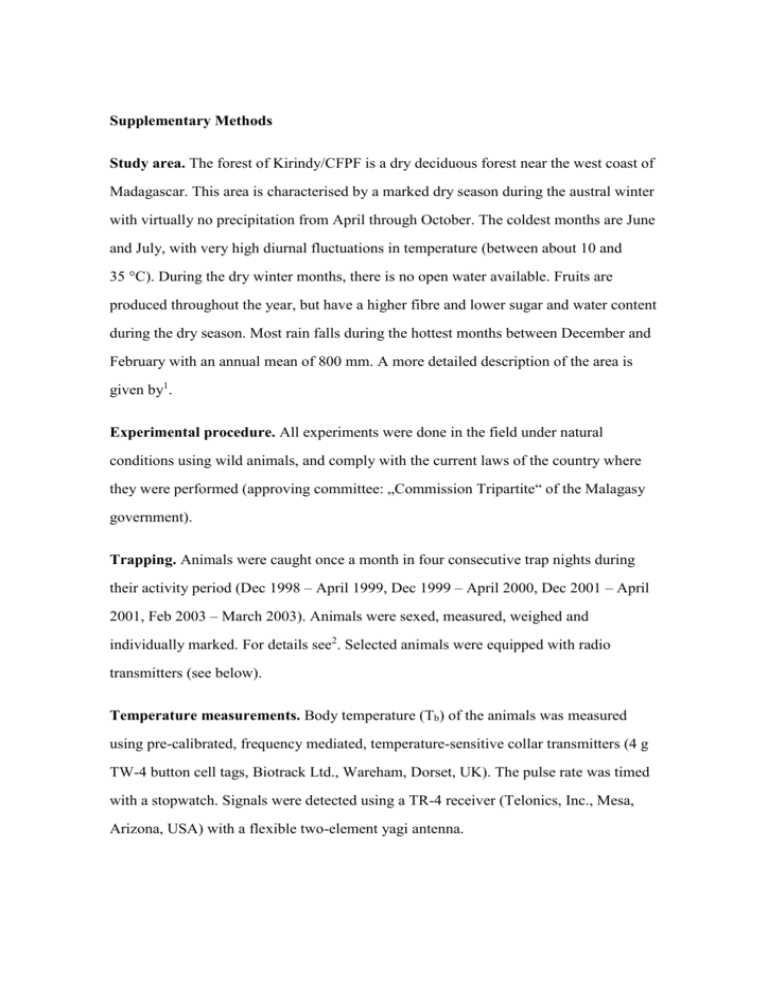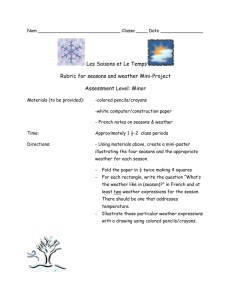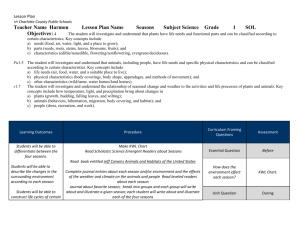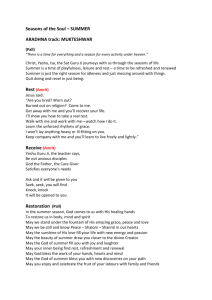Nature template
advertisement

Supplementary Methods Study area. The forest of Kirindy/CFPF is a dry deciduous forest near the west coast of Madagascar. This area is characterised by a marked dry season during the austral winter with virtually no precipitation from April through October. The coldest months are June and July, with very high diurnal fluctuations in temperature (between about 10 and 35 °C). During the dry winter months, there is no open water available. Fruits are produced throughout the year, but have a higher fibre and lower sugar and water content during the dry season. Most rain falls during the hottest months between December and February with an annual mean of 800 mm. A more detailed description of the area is given by1. Experimental procedure. All experiments were done in the field under natural conditions using wild animals, and comply with the current laws of the country where they were performed (approving committee: „Commission Tripartite“ of the Malagasy government). Trapping. Animals were caught once a month in four consecutive trap nights during their activity period (Dec 1998 – April 1999, Dec 1999 – April 2000, Dec 2001 – April 2001, Feb 2003 – March 2003). Animals were sexed, measured, weighed and individually marked. For details see2. Selected animals were equipped with radio transmitters (see below). Temperature measurements. Body temperature (Tb) of the animals was measured using pre-calibrated, frequency mediated, temperature-sensitive collar transmitters (4 g TW-4 button cell tags, Biotrack Ltd., Wareham, Dorset, UK). The pulse rate was timed with a stopwatch. Signals were detected using a TR-4 receiver (Telonics, Inc., Mesa, Arizona, USA) with a flexible two-element yagi antenna. Tb was recorded in hourly intervals for periods of up to 26 continuous days. During the entire study (1999-2003) Tb records from 53 different adult individuals (33 males and 20 females) were obtained for a total of 105 days during the rainy season (activity period; February – March), 94 days during the transition period (April), and 1836 days during the dry season (period of hibernation; May – August). For calibration of this method, four animals were equipped with both, intraperitoneally implanted (4 g, Ökokart, Munich, Germany) and collar transmitters. The accordance between the measurements of the two kinds of transmitters proved to be extremely high, especially during the phases of inactivity, when the animals curl up with the collar transmitter positioned firmly inside (in prep. by K.H.D.). Thus, the data gained by the collar transmitters closely reflect the core Tb and were sufficiently accurate for this study, especially during hibernation. Furthermore, six animals (three males and three females) were subcutaneously implanted with temperature loggers (3 g, thermochron i-buttons, Dallas Semiconductor, USA) during one study period (2001). However, only four animals (one male and three females) could be recaptured after the hibernation period, yielding 343 days of body temperature records during the hibernation period. For some animals, data were collected over several seasons, resulting in a total of 66 animal seasons (Tab. S1). For the analyses, means of each animal per season were calculated. Whenever data from more than one season were available for an individual, only the season with the most data points was used. Therefore, every animal was included only once in the analyses, and N refers to the number of different animals considered in the analyses, whereas n gives the total number of analyzed data points pooled together for all analyzed animals. 1 Wherever possible, relevant ambient temperature (Ta) and tree hole temperature (Th) were measured together with Tb, using temperature loggers (TinyTalks, Orion Components, Chichester, UK; thermochron i-buttons). Th was taken with loggers placed inside the tree holes about 10 cm away from the animals. Ta was obtained with data loggers which were installed on the southern (shady) side of the tree at the height of the tree hole and covered from direct sun with a white roof. Measurements were recorded continuously every 20 or 30 minutes. Radio-tracking. Sites of the sleeping holes of the radio-collared animals were determined daily with the help of the transmitters and telemetry equipment. Whenever the sleeping hole was at a height of less than 4.5 m, identities of the animals were additionally checked with the transponder reading system. 2 Table S1 Number of study animals total one season two seasons three animal seasons seasons females 20 16 3 1 25 males 33 25 8 - 41 N= 53 41 11 1 66 Overview over the number of animals used for body temperature measurements over the entire study period (1998-2003). Total gives the total number of different individuals measured, animal seasons shows the number of available data sets, including multiple seasons per animal. 3 Reference List 1. Ganzhorn, J. U. & Sorg , J.-P. Ecology and Economy of a Tropical Dry Forest in Madagascar. (Erich Goltze GmbH & Co KG, Göttingen, 1996). 2. Fietz, J. & Ganzhorn, J. U. Feeding ecology of the hibernating primate Cheirogaleus medius: how does it get so fat? Oecologia 121, 157-164 (1999). 4








